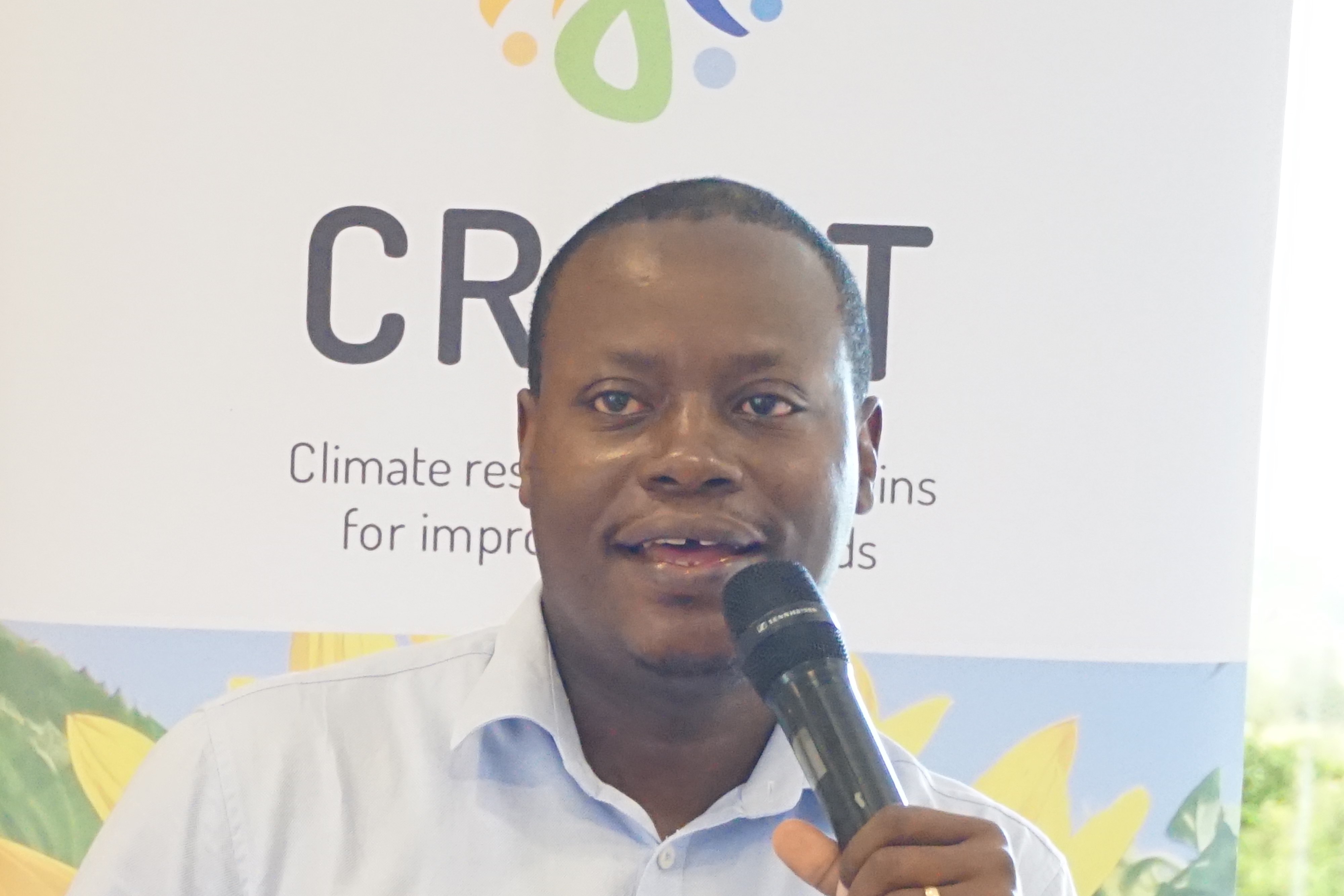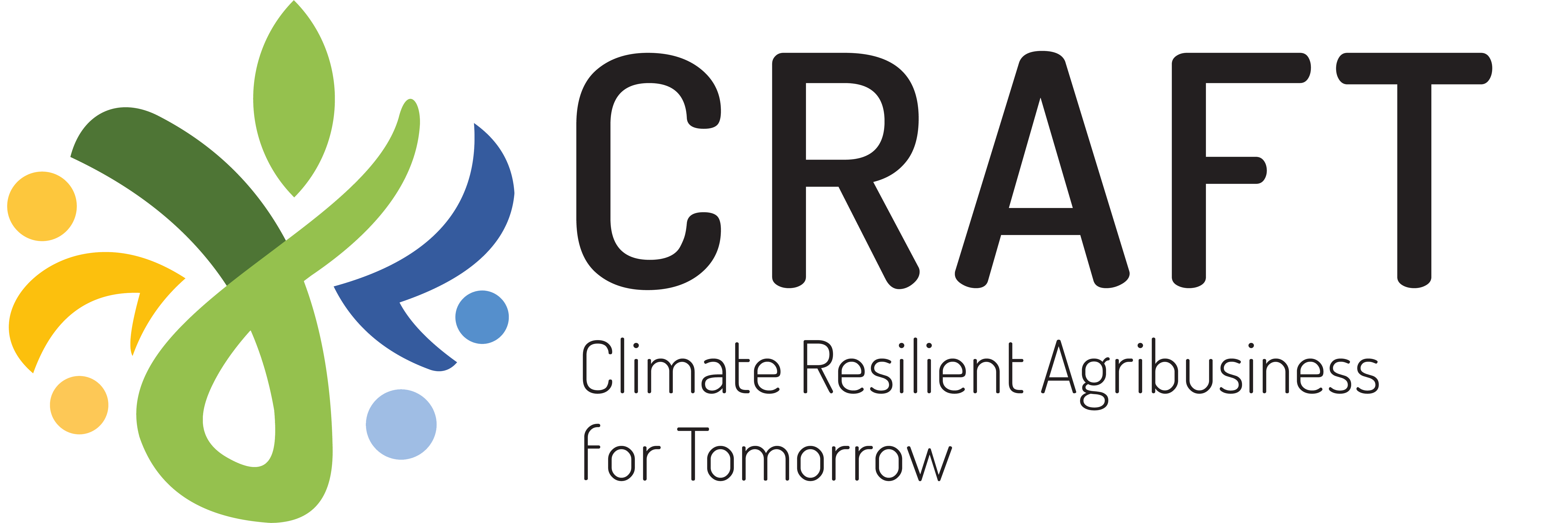Allan Wayira is a Senior Agribusiness advisor for the CRAFT project in Uganda. He is the longest serving member of the CRAFT team. He joined CRAFT project in August 2018, just three months after the project started. Allan shares his experience working with the project.
What is your role in CRAFT?
I support private sector entities, partnering with CRAFT to develop and implement climate smart agriculture (CSA) interventions and integrate them into prioritized value chains. I ensure roll-out and implementation of the project by providing technical backstopping, monitoring progress, and reviewing quality and performance of the entities. By working with our consortium partners, I provide support in leveraging climate finance through brokering access to finance with financial service providers and support CSA multistakeholder processes (e.g., policy dialogues, CSA manual development).
In Uganda, CRAFT is working with 20 agri-SMEs, which we call business cases. Six of these BCs are cooperatives, 16 are SMEs, and two are service providers (SPs), who are operating in four value chains - sesame, sunflower, potato, and soybean, which has the largest number of BCs.
The two service providers cut across four value chains, providing services to several businesses that we are working with. These private sector companies are the vehicles we are using to drive uptake of CSA technologies or /adaptation strategies among smallholder farmers (SHFs).
As a project, we are looking at two levels of adaptation and resilience, first at business level and secondly at farmer level. There are several interventions we do at business level to interest the agribusinesses to adopt CSA practices within their business operations and use that channel to deliver CSA technologies to SHFs.
What has been your experience working with the BCs?
Most of the BCs were not aware of CSA interventions and were not integrating climate risks in their business plans and operations. In addition, some of them faced management challenges. For example, some had few staff and most only focused on their core business which is off taking, aggregating, and processing. They were not interested in providing extension services or providing CSA advisories, because this comes with extra operational costs.
Our starting point was conducting climate risks assessments (CRA) workshops with the BCs. We worked with them to appreciate climate risks that they are likely to face and the impact on their businesses in the short and long term. This involved looking at climate trends and projections and how their businesses can tackle the problem of climate change. We also worked with them to develop climate smart business value propositions and financial projections accruing from investments in CSA. These projections gave them a picture of how they would profit from CSA investments. Together, we developed new business strategies, trained their extension staff in CSA practices, trained them in financial management, good governance, and business skills, and facilitated access to financing.
My experience after our interventions is that many of the BCs have seen the benefits of investing in adaptative strategies. They are going an extra mile to get loans from financial institutions or use their own savings, in addition to the CRAFT grant, to invest in these strategies.
With this investment, the Agri-SMEs support their farmers adopt CSA practices and technologies like using improved seeds, post-harvest technologies, soil testing, and proper threshing leading to bigger volumes and better quality of produce.

The BCs have also been able to improve their business processes in terms of governance and fiscal management. This has enabled them to broker better deals with other partners such as input suppliers, financial institutions, and service providers like insurance and soil testing providers.
We have also seen local governments coming in to support with extension services, and train and provide advisories to the farmers.
Would you recommend using private sector to cascade CSA practices for SHFs?
I would highly recommend working with the private sector. Projects are short term and they come with limited resources but when you work with business entities, you can leverage resources and finance from private sector, and increase impact.
Also, the private sector is the best vehicle to ensure that innovations like seed, insurance and soil testing reach every farmer.
How has CRAFT used climate science to encourage the adoption of CSA practices?
The project has done a couple of projections and they show that in 50 years to come, the temperatures is going to increase by about 2°, and beyond. With these projections, CRAFT has interested and created awareness with policy makers to make climate sensitive policies.
We have also trained extension workers on climate change, its impacts and adaptation strategies as they are the foot soldiers giving advisories to SHFs. Also, as a project, we have been translating climate risks into adaptation measures and these adaptation measures are business opportunities for many of the private sector entities. We have also incorporated climate science in our CSA Training manuals to inform our practices for the farmers and other stakeholders.
What has been your key learnings and lessons on working with farmers and private sector to scale CSA practices?
Market access: To scale the adoption of CSA practices, there must be a guaranteed market. A farmer will only invest in CSA practices if it makes business sense because many famers will only grow a crop when they are sure that there is a rewarding market to cover their investment costs. For example, if a farmer uses improved hybrid seeds, which are more expensive than home saved seed, the farmers will need to recover that investment. Therefore, using private sector companies as entry points works well as they will be able to offtake and guarantee a market.
Credit: For adoption of CSA practices to scale, there must be access to finance/credit. Farmers will invest in CSA practices and technologies when they are able to access credit.
Enabling environment is also very crucial in cascading adaptive measures. There should be structures to provide knowledge or extension advisories to farmers.
Financial Institutions still see agriculture and farming as a risky business. One of the interventions is introducing guarantee schemes, because financial institutions will only lend to the farmers when they are sure that there is something that can cushion the risk.
Also, projects should work with financial institutions to lower the interest rate so that the cost of capital is affordable to the SHFs. It does not make business sense for the farmer to get credit at an interest rate of 25% or more because it is too high. If we want SHFs to access finance, the projects should come in and subsidise or buy down the interest rates. For example, CRAFT subsided the interest rate for Masindi SACCO, with farmers accessing the loans through the SACCO. This worked well for both the farmers and the commercial banks.
In addition, the commercial banks should come in with tailored products for farmers. Many of the loans provided to farmers are business loans. However, agriculture is seasonal bound with a period where the farmer cannot pay back. Therefore, agriculture loans should come with a grace period of up to six months.
What are some of the adaptation measures that have not worked well in the project?
The uptake of crop insurance was a challenge because of limited awareness and information of how insurance works. When farmers are paying premiums with insurance companies, they automatically expect to be compensated, and yet insurance pay-outs are based on satellite information which generalises data and does not consider the weather conditions in a specific area. For instance, with Popular Knowledge Women’s Initiative Farmer to Farmer Cooperative (P’KWI) farmers paid their premiums and suffered losses due to drought. However, when the satellite report came out, it showed that that area did not experience drought, so the farmers complained because they had experienced major losses and in the next season the farmers declined to take up insurance because they were not compensated.
Access to weather information, though necessary, is sometimes not timely or specific enough. This leaves the farmers to survive on their own since weather information is sometimes not reliable.
What are your key recommendations?
Beyond looking at the target value chains that we’ve been working on as a project; it is good to broaden and know that the farmer is not only producing soybean. We should have a wholistic kind of thinking – that is a farming systems’ thinking which we have been mindful of in CRAFT. However, it is something that needs to be brought to the forefront even as we are talking with financial institutions, and interesting them to give credit to the farmers, the farmers will not only be growing soybeans. This crop diversification is a risk mitigation measure for the farmer, and this might also be of interest to the bank since there is likely to be more sources of income and regular cash flow from various enterprises.
What is the CRAFT doing to ensure Sustainability of the interventions for smallholder farmers?
To ensure suitability, we have partnered with a financial service provider called ACELI Africa which will continue working even beyond CRAFT. ACELI, which provides an incentive to financial institutions to lend to SMEs, will work with our partners, (BCs) to continue providing technical assistance, make them investment ready and link them to financial institutions. which Another way we are ensuring sustainability is working with government structures. CRAFT has trained extension workers, alongside the BCs, in CSA practices and technologies using the farmer field school approach. The government extension workers have been working alongside the private extension workers to deliver CSA messages to the SHFs.









